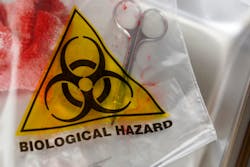Contaminant of the Month: Medical wastes
What are medical wastes?
- Medical wastes consist of pharmaceuticals, antibiotics, microbes and pathogens, excreta and other fluids secreted by patients, blood and other biological and anatomical products from surgery, shower water, laundry releases, and disposable solids.
- Medical facilities are widely distributed. Waste sources include hospitals, physician offices, outpatient clinics, dialysis centers, hospice, mortuary and autopsy centers, animal research facilities, blood banks, nursing homes and dentist offices.
- Chemotherapies are usually carcinogenic, and they can enter the environment by excretion and disposal if they are not isolated.
- Radioactive isotopes such as iodine (I) 131 and I 132 are used as tracers for diagnostic procedures, for example for thyroid, and these will eventually be excreted. Fortunately they have short half-lives of about 8 days for I 131 and about 13 hours for I 132.
- Many wastes are not discharged to the environment solely from hospitals and health care facilities, but can also be released by medications and therapies taken during outpatient treatments as well as over-the-counter therapeutics.
- The general population is always discharging pathogens, pharmaceuticals, natural and synthetic hormones and their metabolites to sewage systems.
Medical waste management
- Waste disposal practices are not nationally uniform and vary by state, locality or facility.
- Solid and biological wastes are usually isolated and disposed of separately and often incinerated.
- These include gloves, excess drugs and blood-soaked bandages that should be isolated and incinerated or disposed of in controlled landfills.
- Pretreatment of wastes such as blood prior to release to sewage is also important.
Release to wastewater
- U.S. hospitals and health care facilities are major consumers of water. They use about 7 percent of all water consumed by commercial and institutional facilities, totaling approximately 133 billion gallons per year.
- Average water consumption has been estimated to be about 145,000 gallons per hospital bed per year.
- Much medical waste is discharged to the sewage system to be managed by the wastewater treatment facilities.
- Many hospitals have procedures to isolate infectious wastes and pretreat them prior to disposal.
- During the recent Ebola virus event, some wastewater facilities threatened not to accept sanitary wastes from medical facilities treating infected patients, and similar issues arose many years ago during the early days of AIDS.
Water treatment
- Even well-designed tertiary wastewater treatment facilities are not capable of removing all the potential pharmaceuticals and microbes that could be released to sewage from health care facilities or the general public.
- Disinfection is substantial, but usually only partially effective; for example, breakpoint chlorination is usually not practiced.
- Chemical removal is partial and selective, even if adsorption and oxidation are used. Therefore, trace levels of chemicals can be released to the environment and also sometimes reach drinking water supplies.
- Concerns have also been expressed about releases of antibiotic-resistant organisms from treated patients and possibly from plasmid transfers between microorganisms during sewage collection and treatment.
- Sludges are likely concentrated sources of many of the persistent contaminants, so their management is also important.
Regulation
- Federal regulations and guidance on the disposal of medical wastes exist, but much is relegated to state or local control. Management practices that include the isolation of wastes, pretreatment and controls imposed on facilities vary nationwide.
Conclusion
- More regulatory oversight is likely necessary to improve the level and national uniformity of medical waste management and assure the protection of public health.
Dr. Cotruvo is president of Joseph Cotruvo and Associates, LLC, Water, Environment and Public Health Consultants. He is a former director of the U.S. EPA Drinking Water Standards Division.
